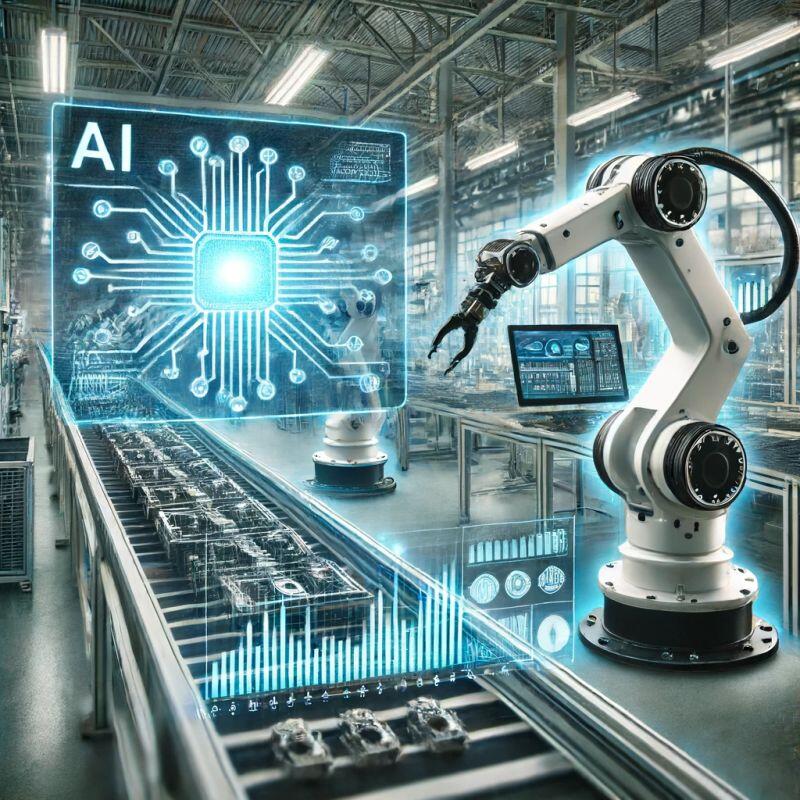AI in Manufacturing: Powering the Next Industrial Revolution
Introduction
A significant change is occurring in the manufacturing sector. Artificial Intelligence (AI) is becoming a key force behind innovation,
efficiency, and resilience in the industry as the Fourth Industrial Revolution develops. AI is radically altering how companies function
and compete in a global market, from supply chain optimisation and smart robotics to predictive maintenance and quality control. This blog examines the most significant uses of AI in manufacturing, its advantages, and how it is paving the way for a future of data-
driven, intelligent, and agile production.

The Rise of Smart Manufacturing
IoT (Internet of Things), automation, and artificial intelligence are all combined in smart manufacturing to create intelligent, networked
production environments. Large volumes of data are gathered and analysed in real time by these systems, which improves decision-
making, productivity, and product quality.
1. Predictive Maintenance: Improving Efficiency and Reducing Downtime
Time, money, and productivity are all negatively impacted by unplanned equipment breakdowns. AI's predictive maintenance helps
address this issue.
How it operates:
- Sensors gather machine data in real time, including temperature, vibration, speed, and more.
- AI systems examine trends and identify abnormalities
- maintenance is planned ahead of time to prevent malfunctions.
Benefits include:
- Longer equipment lifespan
- Lower maintenance expenditures
- Less downtime and operational disruptions
Predictive maintenance guarantees that factories operate more efficiently, potentially preventing millions of dollars in losses each
year.
2. Quality Control with Computer Vision
Product flaws can result in costly recalls and damage a brand's reputation. Real-time visual inspections are now possible with AI-
powered computer vision systems that are significantly more accurate than human eyes.
Features include:
- Recognising surface flaws, misalignments, or missing parts in images
- High-speed automated assembly line detection
- Ongoing learning to adjust to new flaws
AI lowers waste, guarantees greater product uniformity, and saves labour expenses associated with inspection.
3. Supply Chain Optimization
By predicting demand, locating bottlenecks, and improving delivery schedules, artificial intelligence (AI) turns conventional supply chains
into intelligent and responsive networks.
Supply chain AI capabilities include:
- Demand forecasting based on market and historical data
- Inventory management with dynamic replenishment
- Logistics route optimisation
- Risk assessment and mitigation in sourcing.
This results in more flexibility in erratic markets, quicker reaction times, and reduced inventory holding costs.
4. Industrial Robotics for Process Automation
Industrial robots can now do complicated jobs with more flexibility, accuracy, and safety thanks to artificial intelligence.
AI-powered robots are able to:-
- Work together with human employees (cobots)
- Modify activities in response to real-time input
- Learn from previous operations to increase efficiency
Manufacturers can now grow production and satisfy shifting client demands without adding more employees thanks to the transition
from static automation to adaptive AI robotics.
5. Sustainability and Energy Efficiency
By optimising energy consumption patterns across production lines, artificial intelligence (AI) makes a substantial contribution to energy management and sustainable manufacturing.
Applications:
- Real-time machine energy consumption monitoring
- idle energy consumption reduction
- high-usage period prediction and schedule optimisation.
cheaper carbon emissions, cheaper energy costs, and support for ESG (Environmental, Social, and Governance) objectives are the outcomes.
6. Simulation and Product Design
By offering clever design recommendations and modelling performance prior to physical prototyping, AI assists engineers and
designers in reducing development times.
Use Cases:
- Generative design: AI suggests different designs according to performance standards.
- Digital twins are real-time virtual representations of tangible goods.
- Using simulation data to iterate products more quickly
This results in more inventive, optimised products and a quicker time
to market.
7. Safety and Workforce Augmentation
By boosting decision-making, eliminating repetitive activities, and enhancing workplace safety, AI also helps the human worker.
Examples:
- Wearables that track employee health and weariness
- AI-based safety monitoring (e.g., real-time identification of hazardous behaviours)
- AR-powered training for employees on complex machinery
AI reduces risk and effort while enabling humans to concentrate on strategic and creative jobs, not replacing them.
Challenges and Considerations
Although AI in manufacturing has revolutionary potential, adoption is fraught with difficulties of its own:
- High upfront costs for digital infrastructure
- worker skill gaps in AI and data analytics
- data security issues with linked devices and systems
- maintaining compatibility with legacy equipment
Cross-functional cooperation, upskilling programs, and a solid digital transformation plan are needed to address these.
Conclusion: The Future of Manufacturing is AI-Driven
Artificial intelligence is becoming a need for manufacturers who need to remain efficient, competitive, and prepared for the future. AI is
propelling a new era of intelligent, robust, and sustainable manufacturing, whether it is through improving worker productivity,
streamlining supply chains, or enabling predictive maintenance. AI will continue to be at the forefront of innovation as the sector
develops, allowing companies to grow, adjust, and prosper in a world that is becoming more interconnected and complex.

